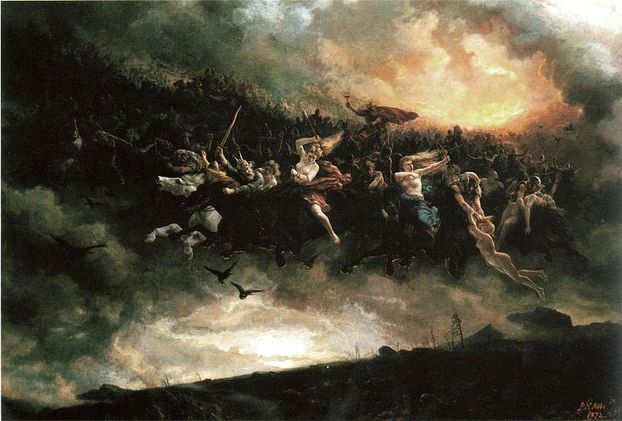Remember the other day I wrote about Yule? I mentioned the "Wild Hunt" celebration to Odin, but didn't quite know anything about it. So let's change that!
Contrary to what I thought, the "Wild Hunt" doesn't appear only in Norse legends, but also in English, Irish and even Catalan folklore. Nevertheless, the Norwegian, Swedish and Danish versions are quoted more often, and probably the myth's origin comes from them (this ancient folk myth was prevalent across Northern, Western and Central Europe).
The fundamental premise in all instances is the same: a phantasmal, spectral group of huntsmen with the accoutrements of hunting, with horses and hounds in mad pursuit across the skies or along the ground, or just above it. The hunters may be the dead or the fairies (often in folklore connected with the dead). The hunter may be an unidentified lost soul, a deity or spirit of either gender, or may be a historical or legendary figure like the Danish king Valdemar Atterdag, the Welsh psychopomp Gwyn ap Nudd or the Germanic Woden (or other reflections of the god Odin). The hunted could be a female troll (called "Slattenpat"), an innocent or guilty young woman, a ghost bear, or other supernatural beings.
Seeing the Wild Hunt was thought to presage some catastrophe such as war or plague, or at best the death of the one who witnessed it. Mortals getting in the path of or following the Hunt could be kidnapped and brought to the land of the dead. Others believed that people's spirits could be pulled away during their sleep to join the cavalcade. In many versions, a person staying right in the middle of the road during the encounter is safe. People who spoke kindly to the hunt, or helped them, were rewarded, often with silver, gold, or even a part of the hunted - such as an animal or human leg - which was often cursed in a way that made it impossible to be rid of it. In this case, the person had to find a priest or magician able to ban it, or trick the Wild Hunt into taking the leg back by asking for salt, which the hunt can not deliver.
Contrary to what I thought, the "Wild Hunt" doesn't appear only in Norse legends, but also in English, Irish and even Catalan folklore. Nevertheless, the Norwegian, Swedish and Danish versions are quoted more often, and probably the myth's origin comes from them (this ancient folk myth was prevalent across Northern, Western and Central Europe).
The fundamental premise in all instances is the same: a phantasmal, spectral group of huntsmen with the accoutrements of hunting, with horses and hounds in mad pursuit across the skies or along the ground, or just above it. The hunters may be the dead or the fairies (often in folklore connected with the dead). The hunter may be an unidentified lost soul, a deity or spirit of either gender, or may be a historical or legendary figure like the Danish king Valdemar Atterdag, the Welsh psychopomp Gwyn ap Nudd or the Germanic Woden (or other reflections of the god Odin). The hunted could be a female troll (called "Slattenpat"), an innocent or guilty young woman, a ghost bear, or other supernatural beings.
Seeing the Wild Hunt was thought to presage some catastrophe such as war or plague, or at best the death of the one who witnessed it. Mortals getting in the path of or following the Hunt could be kidnapped and brought to the land of the dead. Others believed that people's spirits could be pulled away during their sleep to join the cavalcade. In many versions, a person staying right in the middle of the road during the encounter is safe. People who spoke kindly to the hunt, or helped them, were rewarded, often with silver, gold, or even a part of the hunted - such as an animal or human leg - which was often cursed in a way that made it impossible to be rid of it. In this case, the person had to find a priest or magician able to ban it, or trick the Wild Hunt into taking the leg back by asking for salt, which the hunt can not deliver.
~Ally

 RSS Feed
RSS Feed